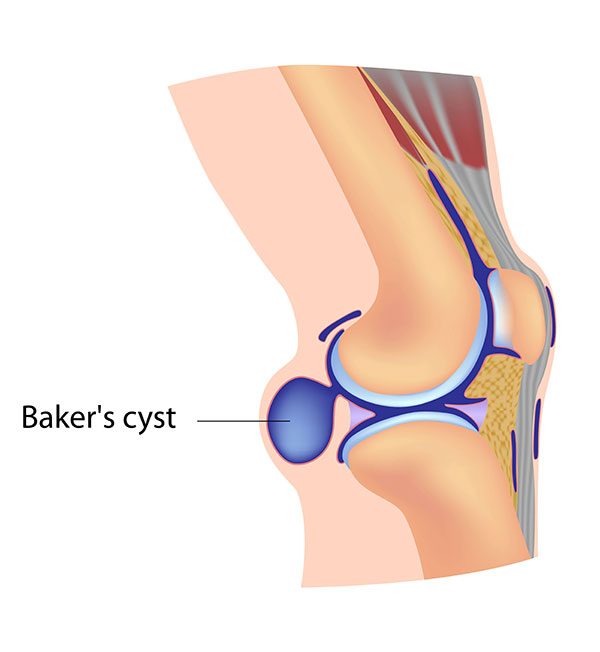Understanding Baker’s Cysts
Things to remember | Symptoms | Causes | Complications | Diagnosis | Treatment | Prevention | Where to get help | How we can help | More to explore | Download PDF

Things to remember
- The knee contains sacs of fluid called bursa that help cushion the joint and reduce friction between the structures around it
- A Baker’s cyst is a swelling on the back of the knee caused by a build-up of excess fluid inside the bursa
- Treatment may include rest, physiotherapy, draining the fluid, cortisone injections and treating the underlying cause.
Your knee is a large and complex joint where three bones meet—your thigh bone (femur), shin bone (tibia) and kneecap (patella).
Surrounding the joint is a tough capsule filled with a lubricating fluid called synovial fluid. This fluid allows your knee to move freely. Small fluid-filled sacs, known as bursa, cushion the joint and help reduce the friction between tissues caused by movement.
When your knee produces too much synovial fluid, the excess fluid causes the bursa behind the knee to expand and bulge. This is a Baker’s cyst. It may also be called a popliteal cyst. Baker’s cysts can vary in size.
Symptoms
Often there are no symptoms and you may not even know you have a cyst.
If symptoms do occur they can include:
- lump or swelling behind the knee
- pain
- stiffness or tightness of the knee.
Causes
Some of the common causes of Baker’s cyst include:
- injury – trauma or injury to the knee can cause a build-up of excess fluid
- torn cartilage – cartilage is a thin cushion on the ends of your bones
- arthritis – particularly rheumatoid arthritis and osteoarthritis
- infection – can cause fluid to build up around the knee joint
- unknown causes – Baker’s cysts can sometimes develop for no apparent reason.
Complications
The symptoms of a Baker’s cyst are usually mild, however sometimes complications can develop, such as:
- the cyst continues to grow, causing your symptoms to worsen
- the cyst may extend down into your calf muscles
- the cyst may burst, leaking fluid into the calf region; this can cause increased pain and bruising around the ankle.
If you experience any swelling or warmth in your calf, you should seek medical advice quickly.
It can be difficult to tell the difference between the complications of Baker’s cyst and more serious but less common problems such as a blood clot in the vein. So it’s better to be safe and get it checked out.
Diagnosis
A Baker’s cyst may be diagnosed using a number of different methods, including:
- physical examination of your knee
- taking your medical history to see if you have any conditions that may cause a Baker’s cyst (e.g. rheumatoid arthritis)
- x-ray – this won’t show the cyst, but can show the presence of arthritis in the knee, which may be causing the problem
- shining a light through the cyst (transillumination) – to see if the mass is filled with fluid
- ultrasound or magnetic imaging resonance (MRI).
Treatment
Baker’s cysts don’t always require treatment as they can get better and disappear on their own.
If treatment is needed, options can include:
- treating the underlying cause, such as medication for arthritis or rest and ice for torn knee cartilage
- temporarily avoiding activities that aggravate your knee joint
- physiotherapy which may include heat or ice treatment and exercises and stretches to maintain the mobility and strength of your knee
- using crutches to take the weight off your knee
- cortisone injections to reduce inflammation
- inserting a needle into the cyst and draining the fluid
- surgery may be required in some cases to remove the cyst if all other treatments haven’t worked.
Prevention
Knee joints are susceptible to injury during sporting activities. Preventing knee injuries from occurring can reduce the risk of a Baker’s cyst developing in the first place or coming back.
Things you can do to prevent knee injuries:
- warm up and cool down before and after exercising or playing sports
- wear supportive footwear
- try to turn on the balls of your feet, rather than through your knees to help avoid knee injuries
- if you injure your knee, stop your activity immediately, apply ice packs to treat the swelling and seek medical advice.
Where to get help
- Your doctor
- Sports medicine professional
- Physiotherapist
- Musculoskeletal Health Australia
Back Pain | Arthritis | Musculoskeletal Conditions (B.A.M) Helpline: 1800 263 265
How we can help
Call our Helpline and speak to our friendly team: phone 1800 263 265 or email helpline@muscha.org
We can help you find out more about:
- Baker’s cysts and other musculoskeletal conditions
- ways to live well with these conditions
- managing your pain
- read our A-Z guide to managing pain
- watch our excellent videos on pain, your brain and how you can retrain your pain system.
- Pain, the brain and your amazing protectometer – Lorimer Moseley
- Treating pain using the brain – David Butler
- upcoming webinars, seminars and other events.
More to explore
Download this information sheet (PDF).
The whole or part of this material is copyright to the State of Victoria and the Better Health Channel. Reproduced with permission of the Victorian Minister for Health. Users are permitted to print copies for research, study or educational purposes.
This information has been produced in consultation with and approved by: Musculoskeletal Health Australia.








